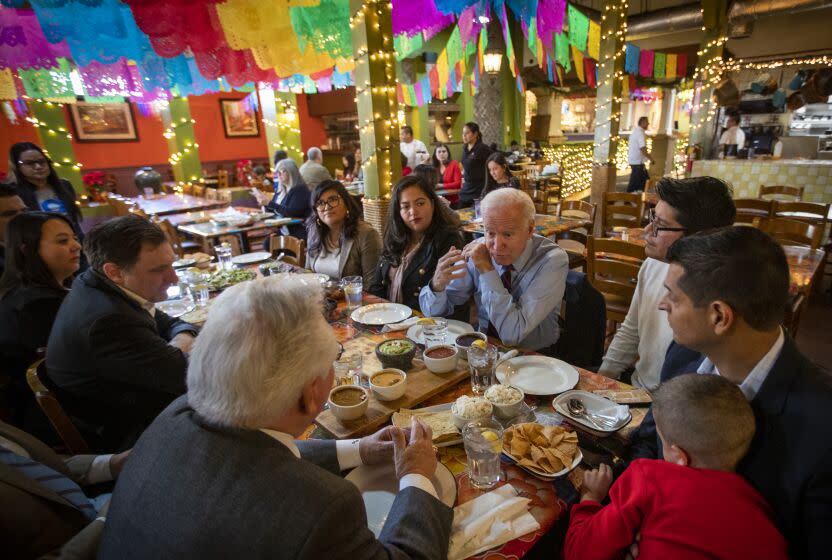Op-Ed: Nury Martinez says out loud the racism and colorism my vibrant Oaxacan community endures

- Oops!Something went wrong.Please try again later.
City Councilwoman Nury Martinez, caught on a leaked audio, says she sees a lot of short, dark people in Koreatown. Martinez says she doesn’t know what “village” they are from and referred to them as “tan feos” — “so ugly.”
My first reaction to these comments was anger, disbelief and sadness. The people that Martinez was referring to are my uncles, aunts, family friends and neighbors. I grew up in Koreatown, a predominantly immigrant community of Koreans and Oaxacans, people from the Mexican state of Oaxaca. We Oaxacans are famous for our tlayudas, memelitas, alebrijes, Oaxaca folklore and, overall, our rich Indigenous culture.
Oaxacans, who come from seven regions of Oaxaca, make up a large portion of those who speak Indigenous languages in California. It is estimated that there are at least 150,000 Oaxacans in Los Angeles — the largest Oaxacan population outside Mexico.
My Oaxacan family’s history in California dates to the mid-1950s when the U.S. began recruiting Mexican laborers to work the farm fields through the bracero program. My great-great-grandfather and his father were braceros who worked picking fruits in California and cotton in Texas. They immigrated from a village in central Oaxaca (Valles Centrales). It was through the bracero program that many Oaxacans first came to California.
Today, Oaxacans live in every part of California. That’s the reason many call this state Oaxacalifornia. My people are farmworkers, dishwashers, cooks, garment workers, janitors, business owners, community members, activists, students and professionals. I’m a USC graduate and a law student at UC Irvine and I too am Oaxacan.
It is stunning to hear a leader of the L.A. City Council make such hateful remarks about a vibrant community whose members help keep this city running. But in some ways, it’s not shocking. For far too long Oaxacans and other Indigenous groups have faced racism and colorism based on their skin color and Indigenous roots. This kind of bigotry has come not only from white people but also from light-skinned Mexicans who view darker, Indigenous Mexicans as inferior.
I know this kind of colorism very well. When I was younger, there was a lot of stigma attached to being Oaxacan and specifically being a darker Mexican. These identities were associated with being Indigenous, which was subject to ridicule and contempt. Growing up, I would often hear darker-skinned Mexicans get called indio or india, meaning “Indian” — words used as derogatory terms for people with Indigenous roots.
These kinds of sentiments have also long been reinforced by the media and film industry, both in Mexico and the U.S. Colorism remains a colonial problem that transcends borders. Shows like “La India Maria,’’ a Mexican production that caricatures and mocks a Mexican Indigenous woman, are a perfect example of how Indigenous communities have been denigrated by other Mexicans, with support from the media.
Mexico has had a very complicated history with colorism, yet as Martinez’s comments show, this bigotry has become rooted in the society and institutions of power in California. My hope is that this incident will lead to meaningful conversations about the prevalence of colorism and racism against Oaxacans and other Indigenous Mexicans in this state.
Martinez, who claims to stand for communities of color, said on the tape, “I don’t know where these people are from.” She added that she didn’t know “how they got here.”
I can tell her that we got here just as other immigrants got here: We came in search of a better life. Many families in my community have been here for generations, and we’re part of the future of Los Angeles. We cannot let these kinds of politicians belittle us or our contributions to this city.
Given what Martinez and Councilmembers Kevin de León and Gil Cedillo, who were also on the tape, have revealed to us, they need to resign from the council. We expect our elected officials to serve and respect not just one group of people, but all the people of L.A. We need leaders who believe in the value of different communities and will work to unify our communities, not divide and disparage them.
I also hope that the City Council takes steps to train and educate their staff about the diverse groups that live in the districts their councilmembers represent. If top political leaders can show this kind of contempt, how are we supposed to hold their staff accountable?
Miriham Antonio is a resident of Koreatown, community advocate and a law student at UC Irvine.
This story originally appeared in Los Angeles Times.

